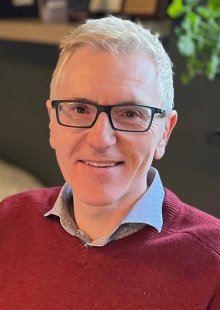
By Yvonne Medina
Dr. Antonio Facchetti, Hightower Chair of Biopolymers, trained as an organic chemist in Italy but switched to materials science for optical application during his Ph.D.; he broadened his interests further after meeting a famous professor at U.C. Berkley while doing his postdoctoral research. He leaped at this opportunity and followed this path into both academia and founding his own companies, first Polyera and then Flexterra, which create flexible and wearable electronic circuit technologies for applications in display, sensors and communication.
He has worked in different aspects of “unconventional electronics” and more recently in the exciting field of bioelectronics which involves combining electronic circuits with biological material. “Being able to couple these two worlds, electronic and biological, and amplify the ionic signals is so important,” he says. One of his projects integrates circuits with plants as they grow. Not only does the material have to be stretchable, but ideally, it should grow with the plant, expanding and contracting in tandem with it. This circuit is in contact with the leaf as it tracks one of the key ions, potassium concentration. Making these circuits stretchable is a huge challenge with important medical and military applications. He claims this work can be a great opportunity for students because there is a lot of work to do with chemistry, materials science and applied physics.
He also has a project he started with the Navy that researches organic materials for solar cells that are much lighter than traditional solar panels. And he has a program that uses metal oxide materials to make materials more stretchable. Exciting opportunities for students to write research papers are around every corner here.
Right now he has a project tracking L1C cells sitting on top of a circuit. He tracks the physiology of the cell and asks questions such as how do they respond to different stimuli? How does the variation of ions and electric potential interact with the cell? How does the addition of a medication change the way the cell evolves? His group works on the circuit board while collaborators study cellular physiology.
In 2005, he started his own company called Polyera, which became Flexterra in 2017. This company aims to replace amorphous silicon circuitry, a brittle material, with mechanically flexible technology that can respond to mechanical deformations, biological processes, and conform to different shapes. Unbreakable tags, rollable maps and wearable technology are just some of these applications. Though he is still involved with Flexterra, he transitioned to working more in academia when the company evolved to focus more on its customers and mass production in Asia instead of research and development.
He said jokingly, “I’m not a spring chicken” to the search committee when he was hired at Georgia Tech. Instead, he brings a wealth of experience in academia and industry to his teaching. This year he will conduct a class with both undergraduate and graduate students.
He argues that material scientists are more adaptable than other types of engineers. Right now there is a need for students who can work with semiconductors. He says in this field, “You can see science and technology in a more integrated manner through exposure to both research and manufacturing. There are always opportunities to expand your knowledge by revisiting the fundamentals and developing new applications for them.” The same flexibility he researches in bioelectronics also applies to material scientists like himself who are well suited for a rapidly changing workforce.